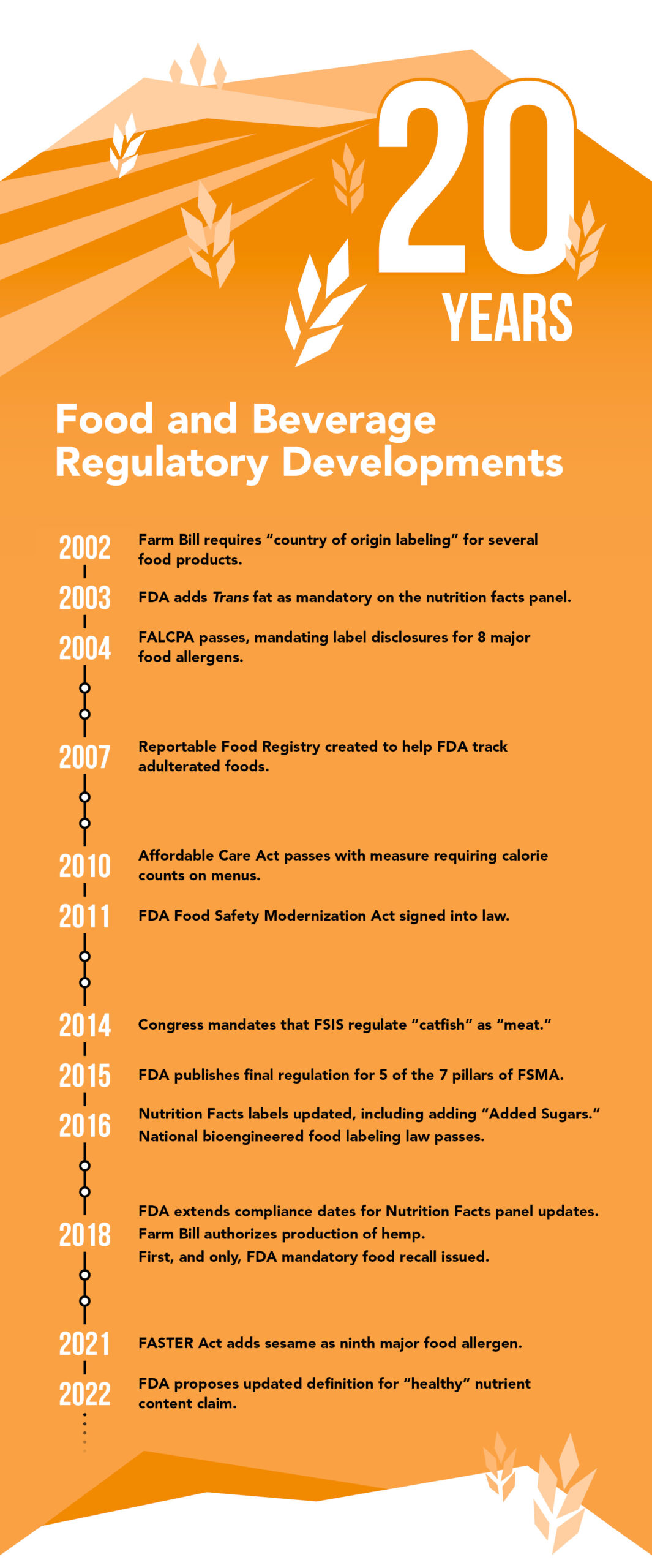Twenty Years of Food and Beverage Regulatory Developments

2002
In the 2002 Farm Bill, Congress amended the Agricultural Marketing Act of 1946 to require retailers to notify their customers of the country of origin of covered commodities.
2003
FDA amended its regulations on nutrition labeling to require the inclusion of trans fats on the Nutrition Facts panel for conventional foods and dietary supplements. The change was intended to help consumers in maintaining healthy dietary practices.
2004
The Food Allergen Labeling and Consumer Protection Act of 2004 sought to help consumers with food allergies and their caregivers to more easily identify and avoid foods containing major food allergens. The Act identified eight major food allergens: milk, eggs, fish, Crustacean shellfish, tree nuts, peanuts, wheat and soybeans.
2007
In its Food and Drug Administration Amendments Act of 2007, Congress required the Secretary of Health and Human Services to establish within FDA a Reportable Food Registry. The purpose of the registry is to provide a reliable means to track patterns of adulterated food and aid FDA in targeting its limited inspection resources.
2010
The Affordable Care Act required that many chain restaurants and other similar retail food establishments list the calorie counts of the food they sell. The final rule took effect in 2018.
2011
Congress passed the FDA Food Safety Modernization Act, allowing FDA to shift its focus to preventing food safety problems rather than just responding to them. The law was the largest overhaul of the country’s food safety system since the passage of the Federal Food, Drug and Cosmetics Act in 1938.
2014
Through the 2014 Farm Bill, Congress amended the Federal Meat Inspection Act, removing the term “catfish” and replacing it with “all fish of the order Siluriformes” as being subject to Food Safety and Inspection Service jurisdiction and inspection. FDA was previously responsible for regulating catfish as “seafood.”
2015
FDA published final rules for five of the seven pillars of the Food Safety Modernization Act, including Preventive Controls for Human Food, Preventive Controls for Animal Food, Foreign Supplier Verification Program, Produce Safety and Accredited Third-Party Certification. The following year, the FDA published final rules for the final two: Sanitary Transportation and Intentional Adulteration.
2016
FDA revised the Nutrition Facts label to highlight calories, servings per container and serving-size declarations through a combination of increased type size and boldface. The update also included requirements for labeling added sugars and Vitamin D and potassium values.
Congress passed the National Bioengineered Food Disclosure Law requiring food and beverage manufacturers to disclose the use of ingredients made with genetically modified organisms (GMOs). The law defined bioengineered foods, required a mandatory standard for disclosure and also allowed certified organic products to bear “non-GMO” labels.
2018
The FDA extended the compliance dates for changes to food nutrition labels to 2020 and 2021. Rules included in the extension included those defining a single-serving container and requiring dual-column labeling for certain containers.
The passage of the 2018 Farm Bill authorized the production of hemp (defined as cannabis and derivatives of cannabis with extremely low concentrations of THC) and removed it from the definition of marijuana in the Controlled Substances Act.
After several products containing powdered kratom that were manufactured, processed, packed or held by Triangle Pharmaceuticals LLC were found to contain Salmonella, the FDA issued its first—and only—mandatory recall order of a food product in order to protect public health.
2021
The Food Allergy Safety, Treatment, Education and Research Act (FASTER) required that, starting on January 1, 2023, any food “introduced or delivered for introduction into interstate commerce” must appropriately declare the presence of sesame as a major food allergen.
2022
The FDA announced a proposed update to guidance on how the term “healthy” can be used in marketing and labeling food products. The proposed framework uses a food-group based approach and would require a food product to be limited in certain nutrients, such as saturated fat, sodium and added sugars.
